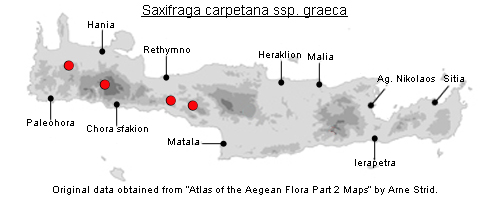
SPECIES DESCRIPTION
SAXIFRAGA CARPETANA subsp. GRAECA
Family and Genus:- See-
Common Names:- None
Homotypic Synonyms:- Saxifraga graeca
Meaning:- Saxifraga (L) Stone-breaker.
Carpetana (L) Of the Carpentano tribe from the Toledo area of Spain.
Graeca (L) Grecian. Greek
General description:- Summer-dormant perennial, with rather large, onion-shaped
bulbils in the axils of the basal leaves at ground level.
Stem:-
1) Flowering,10-40 m, erect, usually solitary, sometimes a few together to form a
lax clump, patent glandular-pubescent.
Leaves:-
1) Basal, long-petiolate, in a rosette, with soft, multicellular, glandular and
eglandular hairs.
2) Cauline, subsessile, flabellate, without bulbils;
a) upper, gradually smaller and more distant.
3) Lamina, 10-20 x 2-25 mm, cordate, flaccid, with 5 -13 shallow lobes.
4) Petiole, 1.5-2 times as long as the lamina, widened above.
Flowers:-
1) Inflorescence, a rather compact cyme of 5-11 flowers.
2) Pedicels, up to 20 mm.
3) Sepals, 2.5-3.5 run, ovate-oblong, subobtuse, green, glandular-pubescent.
4) Petals, 8-12 mm, narrowly obovate, obtuse, 3- to 5-veined, pure white, sparsely
glandular-pubescent on the upper surface.
5) Stamens, less than half as long as the petals.
6) Ovary, 3/4 inferior.
7) styles, very short.
Fruit:-
1) Seeds, 0.5 x 0.35 mm, ovoid, brown, with longitudinal rows of short papillae.
Key features:-
1) Basal leaves, long-petiolate;
2) Lamina, 10-20 x 2-25 mm, orbicular-reniform.
3) Petals, 8-12 mm, narrowly obovate, obtuse, 3- to 5-veined,
Habitat:- Seasonally damp places, open woodland and rub, rock ledges in ravines,
etc., on various substrates, 0-1200(-1750) m.
Distribution:- Almost throughout Greece although rare in the S Aegean area and
the Ionian islands. Spain and N Portugal, NW Africa, S Italy (incl. Sicily) and
Balkan Peninsula from Montenegro and Serbia to the Aegean islands. On Crete
Known from only a few locations in the west. Rare.
Flowering time:- Mar-June.
Photos by:- Dr. Armin Jagel
